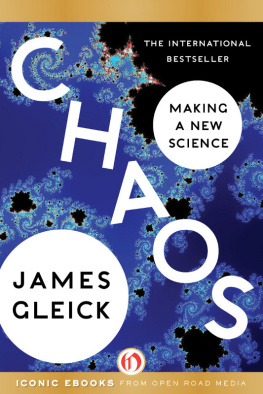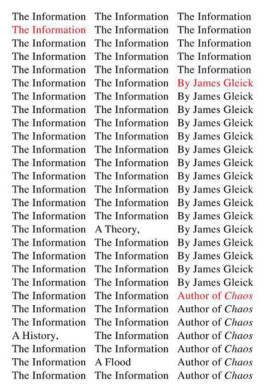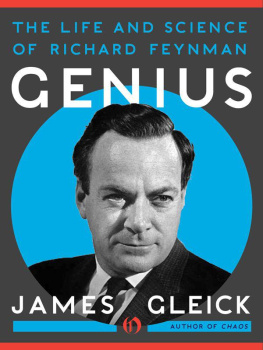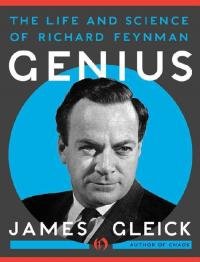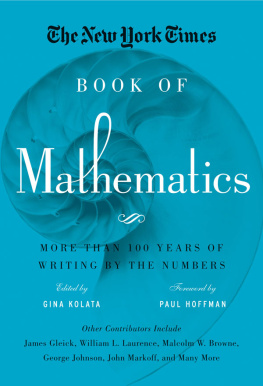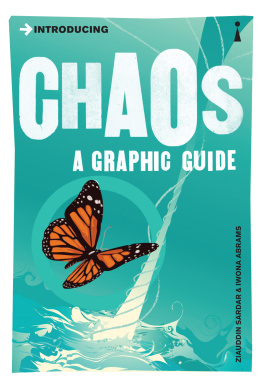
CHAOS
MAKING A NEW SCIENCE

JAMES GLEICK

To Cynthia
human was the music,
natural was the static
JOHN UPDIKE
CHAOS
THE POLICE IN THE SMALL TOWN of worried briefly in 1974 about a man seen prowling in the dark, night after night, the red glow of his cigarette floating along the back streets. He would pace for hours, heading nowhere in the starlight that hammers down through the thin air of the mesas. The police were not the only ones to wonder. At the national laboratory some physicists had learned that their newest colleague was experimenting with twenty-sixhour days, which meant that his waking schedule would slowly roll in and out of phase with theirs. This bordered on strange, even for the Theoretical Division.
In the three decades since J. Robert Oppenheimer chose this unworldly New Mexico landscape for the atomic bomb project, Los Alamos National Laboratory had spread across an expanse of desolate plateau, bringing particle accelerators and gas lasers and chemical plants, thousands of scientists and administrators and technicians, as well as one of the worlds greatest concentrations of supercomputers. Some of the older scientists remembered the wooden buildings rising hastily out of the rimrock in the 1940s, but to most of the Los Alamos staff, young men and women in college-style corduroys and work shirts, the first bombmakers were just ghosts. The laboratorys locus of purest thought was the Theoretical Division, known as T division, just as computing was C division and weapons was X division. More than a hundred physicists and mathematicians worked in T division, well paid and free of academic pressures to teach and publish. These scientists had experience with brilliance and with eccentricity. They were hard to surprise.
But Mitchell Feigenbaum was an unusual case. He had exactly one published article to his name, and he was working on nothing that seemed to have any particular promise. His hair was a ragged mane, sweeping back from his wide brow in the style of busts of German composers. His eyes were sudden and passionate. When he spoke, always rapidly, he tended to drop articles and pronouns in a vaguely middle European way, even though he was a native of Brooklyn. When he worked, he worked obsessively. When he could not work, he walked and thought, day or night, and night was best of all. The twenty-fourhour day seemed too constraining. Nevertheless, his experiment in personal quasiperiodicity came to an end when he decided he could no longer bear waking to the setting sun, as had to happen every few days.
At the age of twenty-nine he had already become a savant among the savants, an ad hoc consultant whom scientists would go to see about any especially intractable problem, when they could find him. One evening he arrived at work just as the director of the laboratory, Harold Agnew, was leaving. Agnew was a powerful figure, one of the original Oppenheimer apprentices. He had flown over Hiroshima on an instrument plane that accompanied the Enola Gay, photographing the delivery of the laboratorys first product.
real smart, Agnew said to Feigenbaum. If youre so smart, why dont you just solve laser fusion?
Even Feigenbaums friends were wondering whether he was ever going to produce any work of his own. As willing as he was to do impromptu magic with their questions, he did not seem interested in devoting his own research to any problem that might pay off. He thought about turbulence in liquids and gases. He thought about timedid it glide smoothly forward or hop discretely like a sequence of cosmic motion-picture frames? He thought about the eyes ability to see consistent colors and forms in a universe that physicists knew to be a shifting quantum kaleidoscope. He thought about clouds, watching them from airplane windows (until, in 1975, his scientific travel privileges were officially suspended on grounds of overuse) or from the hiking trails above the laboratory.
In the mountain towns of the West, clouds barely resemble the sooty indeterminate low-flying hazes that fill the Eastern air. At Los Alamos, in the lee of a great volcanic caldera, the clouds spill across the sky, in random formation, yes, but also not-random, standing in uniform spikes or rolling in regularly furrowed patterns like brain matter. On a stormy afternoon, when the sky shimmers and trembles with the electricity to come, the clouds stand out from thirty miles away, filtering the light and reflecting it, until the whole sky starts to seem like a spectacle staged as a subtle reproach to physicists. Clouds represented a side of nature that the mainstream of physics had passed by, a side that was at once, fuzzy and detailed, structured and unpredictable. Feigenbaum thought about such things, quietly and unproductively.
To a physicist, creating laser fusion was a legitimate problem; puzzling out the spin and color and flavor of small particles was a legitimate problem; dating the origin of the universe was a legitimate problem. Understanding clouds was a problem for a meteorologist. Like other physicists, Feigenbaum used an understated, tough-guy vocabulary to rate such problems. Such a thing is obvious, he might say, meaning that a result could be understood by any skilled physicist after appropriate contemplation and calculation. Not obvious described work that commanded respect and Nobel prizes. For the hardest problems, the problems that would not give way without long looks into the universes bowels, physicists reserved words like deep. In 1974, though few of his colleagues knew it, Feigenbaum was working on a problem that was deep: chaos.
WHERE CHAOS BEGINS, classical science stops. For as long as the world has had physicists inquiring into the laws of nature, it has suffered a special ignorance about disorder in the atmosphere, in the turbulent sea, in the fluctuations of wildlife populations, in the oscillations of the heart and the brain. The irregular side of nature, the discontinuous and erratic sidethese have been puzzles to science, or worse, monstrosities.
But in the 1970s a few scientists in the United States and Europe began to find a way through disorder. They were mathematicians, physicists, biologists, chemists, all seeking connections between different kinds of irregularity. Physiologists found a surprising order in the chaos that develops in the human heart, the prime cause of sudden, unexplained death. Ecologists explored the rise and fall of gypsy moth populations. Economists dug out old stock price data and tried a new kind of analysis. The insights that emerged led directly into the natural worldthe shapes of clouds, the paths of lightning, the microscopic intertwining of blood vessels, the galactic clustering of stars.
When Mitchell Feigenbaum began thinking about chaos at Los Alamos, he was one of a handful of scattered scientists, mostly unknown to one another. A mathematician in Berkeley, California, had formed a small group dedicated to creating a new study of dynamical systems. A population biologist at Princeton University was about to publish an impassioned plea that all scientists should look at the surprisingly complex behavior lurking in some simple models. A geometer working for IBM was looking for a new word to describe a family of shapesjagged, tangled, splintered, twisted, fracturedthat he considered an organizing principle in nature. A French mathematical physicist had just made the disputatious claim that turbulence in fluids might have something to do with a bizarre, infinitely tangled abstraction that he called a strange attractor.
Next page
